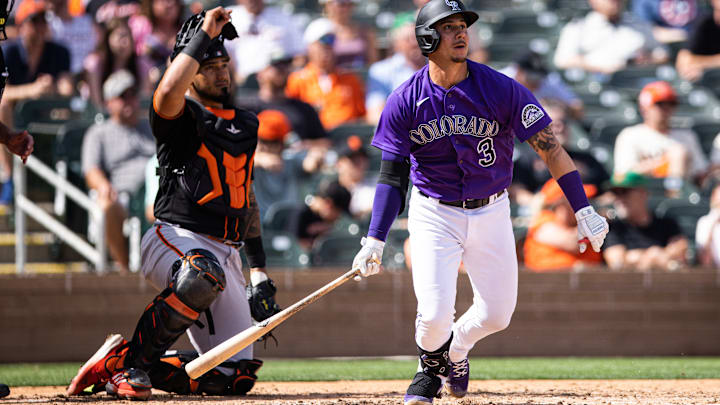How each top 30 SF Giants prospect can take their game to the next level
5. Heliot Ramos
The key thing: Put up the stats
There is a growing vibe that 2022 is a crucial year for Heliot Ramos. It's a prove-it year for him as he might be getting looked at with an open spot for a right-handed bat need in the big league lineup. Ever since his San Jose stint in 2019, Ramos looked kind of mid rather than absolute chad. He's never had a season in the high-Minors where he posted an OPS above .775.
In order to cement himself as still a core part of the future as well as a potential call-up this season, Ramos has to produce in Sacramento. He has to put up the numbers at home considering that Sacramento is a neutral park compared to the absolute jet streams of the other parks in the PCL. Because he was in the organization since 2017, Giants fans are already pretty tired of waiting for him it seems like. However, Ramos looks like he is ready to all-out attack the season with his much-improved physique.
@HeliotRamos loud double to the right center gap today against the reds! pic.twitter.com/0THip14LN8
— _Barmichael916 (@Anthony49208035) March 21, 2022
4. Joey Bart
The key thing: Stay comfortable and confident
Look, Joey Bart's going to leave prospecthood very soon. However, if there is one key thing that he should do this season, it's to stay comfortable. Get comfortable with catching the big league pitching staff. There's a lot of nastiness in that pitching staff that Bart needs to get acclimated to quickly. Also, with the way that the front office operates with one-year "prove it" deals being common, he has to get used to the revolving door of pitchers.
It's easy to mention that cutting down the strikeouts will be the key to Bart's success, but I feel the strikeouts are a part of his game that is almost impossible to delete. Making sure that he is up to the task with his duties as a catcher is the biggest thing for him this season more than anything.
3. Luis Matos
The key thing: Take the free base
Give kudos to the Giants coaching staff for not changing Luis Matos' approach in 2021 because it really, really works when it is on. The issue though is when it was not, and we got a glimpse of that last season. In a stretch from the middle of August until just before the end of the regular season, Matos hit a putrid .178 with a .513 OPS. There was not really a change in the approach as shown by his 13% strikeout rate during the slump, but his walk rate is still at 5% and his BABIP is at .195.
Matos could potentially fall into the Christian Arroyo dilemma where he makes so much contact that he is dependent on the BABIP gods and kind of depend on his ability to put the bat to the ball that he provides very minimal value when he's in a slump. If Matos ever decides to take his walks instead of making contact out of the zone that will most likely lead to outs, that will boost his overall value and he's shown his impressive eye and plate coverage last season.
2. Marco Luciano
The key thing: Make contact on fastballs in the zone
Putting the ability to play shortstop as a key thing for Luciano is a bit of a jebait unless I see something that is completely out of this world from him defensively, it is highly unlikely to happen this season or ever will. For me, it's something that I want to see to believe. Instead, let's take a look at his bat which after the 2021 season raised questions on how good it can be as well.
As I said before, Luciano struggled to catch up to velocity when he is behind in the count last season, and Geoff Pontes of Baseball America (I hope that's his real name this time) mentioned in Roger Munter's podcast that Luciano posted a below-average contact rate on fastballs inside the zone. I do not have the shiny data that he has but just from watching Luciano over the course of the season, it was evident that he is making a concerted effort to make contact on breaking balls, leaving him open to get blown by velocity. If Luciano can improve on it this season, his journey to superstardom is right back on track and that is another reason to not have his defense as the biggest key for him. If everything clicks offensively, it will not matter where will play on the field.
1. Kyle Harrison
The key thing: Just throw a bit more strikes
Throwing strikes is the simplest and most difficult thing to do for any pitcher. Simple in concept but difficult to execute. However, throwing strikes is a key factor in Harrison's success last season. In his first 15 starts, Harrison threw 61% of his pitches for strikes which corresponded to an ERA of 4.12. In his final eight starts, he threw 63% of his pitches for strikes which is just around average. The result, however, is an ERA of 1.53.
You might think that a two percent increase in strike-throwing might not amount to a lot but that is 35 pitches called balls that would have been strikes (Harrison threw 1760 pitches last season, two percent of 1760 is 35) and with the kind of stuff that Harrison has, those 35 balls turned to strikes would mean a lot. It would mean more strikeouts, fewer walks, and more outs. With him turning out in the best shape of his life at training camp, the chances are he will carry over his dominant end of the 2021 season to the upcoming season.
